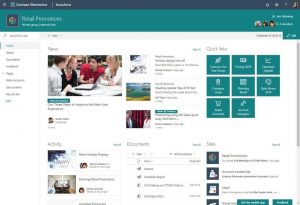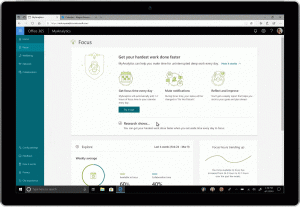
10 tips to have a successful remote workforce

For small and medium businesses, having a remote workforce can make a lot of sense. You’ll widen your talent pool as you’ll be able to hire for skills over proximity. You’ll save money on paying for office space and all the trimmings. And if you or your employees work with customers or partners offsite, it’s easier for them to access the information they need when they need it.
But how can you easily ensure your remote workforce has the same dynamic and trust as an in-house team would? By making use of technology to build trust, connections, and empower them to work in the best way. We take a look at our top 10 tips to managing a remote workforce.
1. Do more in the cloud
To be able to be flexible and access documents anywhere, the first step is become a cloud-first organisation. By moving to the cloud, not only does it mean your employees can easily access documents, data, and information from anywhere, but it also lets you use new cloud-only tech such as AI.
With Azure, you pay only for the cloud services you use, it means you save money on your operation costs, and scale as your business grows. Plus, Azure is built on a secure foundation, with built-in controls to customise your user and data management. But more on that later!
 2. Modern devices
2. Modern devices
It’s great to give your employees laptops to make it easier to work flexibly/remotely. But what will really make their workday even easier? By giving them devices that encourage them to work naturally.
Modern devices that are built with accessibility in mind, such as the Surface, encourage the best work and creativity out of your employees. By making it easier to work, your employees will be more productive and innovative. When you add the Surface and other Microsoft tools and apps such as Windows 10 and Office 365 together, you’ll get a powerful future-ready workforce.
3. Stay secure
It can be a fine balance between making sure your business is secure and compliant and the productivity and flexibility of your workforce, right? But it’s possible to be secure while letting your employees get on with business – you can even increase productivity!
With built-in security built into devices and apps, cybersecurity will become so seamless your employees won’t even realise they’re being protected. And it’s easier for your IT team to manage, protect, detect, and respond. For example, signing into a Surface is linked to an employee’s work account, so they can then instantly access their documents, email, or other apps.
Azure helps protect your data with built-in intelligence, controls, and services that work across identity, data, networking, and apps. The Azure Security Center helps further strengthen your security posture, giving you the ability to detect and protect against threats.
 4. Bring your own device (BYOD) policy
4. Bring your own device (BYOD) policy
We’re all about making work easier for employees. We want them to be able to access what they need, when they need it. And sometimes their phone is going to be quicker than pulling out their work device. That’s why you need to ensure you have a sufficient BYOD policy that let’s your employees use their phones without comprising on security.
Everyone has a different smartphone – whether it’s iOS or Andriod. But what should stay the same is their ability to access what they need and how secure it is.
Azure Active Directory works to create a seamless secure access across a range of devices, cloud, and mobile apps. This means your IT team is in control of your business information while your employees have smooth, instant access to their documents wherever they are. And if that device is missing, stolen, or compromised – your IT team can quickly solve that issue.
 5. A powerful intranet
5. A powerful intranet
SharePoint empowers your organisation to collaborate, share information, and use applications to help make your employees more productive and transform business process.
You’ll have the ability to make sites for every project, team, or department. On these sites your teams can share documents, data, resources, and news securely and efficiently. It also has powerful search and intelligent ways to discover information and insights to guide action. Using SharePoint lists and libraries alongside Microsoft Flow and PowerApps, you can easily create rich experiences with forms, workflows and customise apps. This means you can simplify and transform processes, helping accelerate productivity.
And when you create a SharePoint and document library, you can immediately make a space for it on Teams (and vice versa), making it even easier and quicker to collaborate.
 6. A virtual workspace
6. A virtual workspace
Teams makes it easy to communicate and collaborate on work. It works across all devices and with group chat, online meetings, calling, and web conferencing, you can stay in touch easier than ever. And it’s not just for work, create channels for general water cooler chat and make use of the gif function!
Customise your workspace with the tools you and your team use daily. Add a SharePoint page, or library, Microsoft apps, or even your third-party favourites. With built in Office 365, it makes it easier to collaborate, share documents, and edit. Plus, you benefit from end-to-end security, admin control, and compliance.
7. Planner
Keeping up to date on projects can seem chaotic when your team is spread out across the country. Luckily, there are online tools to help you with that. Planner makes it easy to create new plans, organise and assign tasks, and share files.
Best of all, it makes all tasks visible and transparent. You can see a comprehensive view over employee’s tasks so you can see what stage a project is at and who is on hand to complete it. You can even see the number of tasks each employee has. This makes it easier to improve workloads and help make sure employees don’t feel too stressed or overburdened.
Planner can link into SharePoint and Teams and works across devices so makes it easy for you to see the progress of projects.
 8. Analytics
8. Analytics
Analytics are used for everything these days. Even tracking workloads.
MyAnalytics gives you a personal overview of your work patterns and suggests ways to work smarter. Powered by AI, you’ll get insights to improve your productivity, collaboration, and wellbeing. MyAnalytics is private by design, so each employee will only be able to see their personal insights and take action.
However, viewing a complete overview of your workplace analytics can give you insight into daily collaboration patterns. Insights from these will help your business be more agile, improve employee experience, and help you identify where to focus to create value.
9. Online learning
Re- and upskilling is a vital part of employee engagement. Not only are skilled employees 8.4 percent more productive, but 70 percent of employees are more likely to stay at their workplace if they have training and development opportunities.
For remote teams it can be hard to organise training, but online learning is a great option for on-demand training and development.
[msce_cta layout=”link_only” align=”center” linktype=”blue” linkurl=”https://www.microsoft.com/en-gb/athome/digitalskills/improve/#start” linkscreenreadertext=”Improve your digital skills with these online courses” linktext=”Improve your digital skills with these online courses” ][/msce_cta]
 7. Make time to meet
7. Make time to meet
While we have all the tools at our disposal to communicate and collaborate online, including video calling, sometimes we have to go old-school. Organise team meetings a few times a year where everyone can get together in-person. Use this time to discuss the organisation’s future, strategy, or as a chance for team building and skill development.
Using technology to empower
These tips will help SMBs empower their remote workforce. By using the power of technology, you can create seamless across-device experiences that encourage communication and collaboration.
Teams that work together well, stay together and achieve great results. These tools are there for your team to find their path to success.
Find out more
[msce_cta layout=”image_center” align=”center” linktype=”blue” imageurl=”https://www.microsoft.com/en-gb/industry/blog/wp-content/uploads/sites/22/2018/12/home_effective-people_800x450-e1551172928959.jpg” linkurl=”https://www.microsoft.com/en-gb/business/do-more/effective-people/ ” linkscreenreadertext=”Create effective people” linktext=”Create effective people” imageid=”8218″ ][/msce_cta]
[msce_cta layout=”image_center” align=”center” linktype=”blue” imageurl=”https://www.microsoft.com/en-gb/industry/blog/wp-content/uploads/sites/22/2018/12/traditiona-cloud-1024.png” linkurl=”https://resources.office.com/ww-landing-sbd-7-ways-to-work-smarter-in-the-cloud-ebook.html ” linkscreenreadertext=”7 ways to work smarter in the cloud” linktext=”7 ways to work smarter in the cloud” imageid=”4357″ ][/msce_cta]




